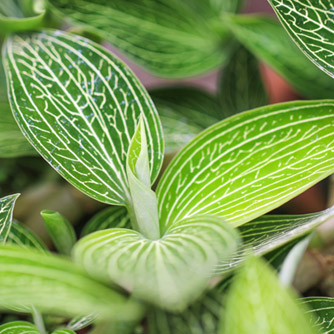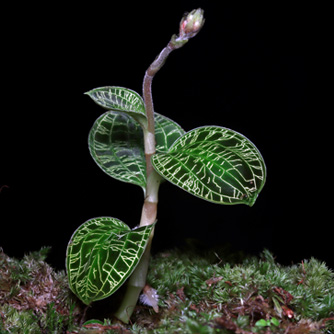Jewel Orchids
BackJewel orchids are definitely not your average orchid. While most orchids are loved for their eye-catching flowers with jewel orchids the attraction is in their velvety foliage that shimmers and shines under the light. They do produce delicate spikes of white blooms but they’re fairly modest and nothing compare to their amazing leaves.
Jewel orchids make excellent house plants and are often used in terrariums as they love the humidity. The only downside is they can be hard to find so keep your eyes peels at nurseries and garden shows or go hunting online.
Varieties of Jewel Orchids
There are quite a few different jewel orchids but the most commonly grown types are:
Ludisia discolor – This popular jewel orchid is much loved for its very dark velvety leaves marked with iridescent white/pink veins. It’s also the easiest to grow so this is a good one to start off your collection. There is also an attractive variety which has light green leaves.
Macodes petola and M. sanderiana – Sometimes called lightning jewel orchids thanks to the gold coloured veins on their leaves which look a little like lightning bolts. They like a very warm and humid environment so it’s best to grow them in a closed terrarium.
Anoectochilus formosanus – another very handsome plant with silvery veins on a dark green velvet backdrop. If you can get your hands on one make sure it’s kept in a warm humid spot.

Dramatic foliage of Ludisia discolor
How to Grow Jewel Orchids
Jewel orchids originate from tropical forests mainly around South East Asia. They are found growing on the forest floor where they thrive in low light. In your own home position them in a spot with bright indirect light and protection from direct light which can burn leaves. Yes they can handle low light levels but their growth will be very slow hence we recommend a brighter spot.
Jewel orchids are terrestrial orchids which means they grow on the ground and put roots in the soil. This is different to other commonly grown orchids like cymbidiums, phalaenopsis and dendrobiums which are epiphytes and would normally growing clinging to trees. This means jewel orchids should not be planted in an orchid bark mix as it will not hold enough moisture. Instead use the same premium potting mix you use for the rest of your indoor plants. Once potted up water in with OCP eco-seaweed to help reduce transplant shock.
Water regularly to keep the soil moist as jewel orchids do not like to dry out. However at the same time they also don’t like being waterlogged. Confused? Just let the top 1-2cm of the potting mix dry out before you water again. The ludisia orchids are the most tolerant of drying out while all of them will rot if their roots become waterlogged.
Jewel orchids prefer high humidity but the ludisia orchids are again the least fussy. The ludisias can often be grown just as a regular indoor plant without any extra humidity. If however you live somewhere with naturally low humidity or you’re growing the other types you will need to boost humidity levels. You can try grouping with other plants, misting regularly or sitting atop a saucer filled with stones and water as the first step. If that isn’t enough, and it often isn’t with these plants, then get yourself a humidifier or grow them in a closed terrarium to maintain humidity. In a terrarium make sure you don’t overwater and cause water to pool in the bottom.
Now remember these are tropical plants so they will need protection from the cold. Keep the ludisia orchids above 10oC whilst the others should stay above 15oC.
Lastly jewel orchids can be grown outdoors in warm tropical climates. You can grow them in pots or try planting them under trees, ensuring the soil is enriched with organic matter and compost prior to planting. Whichever option you choose remember these plants need shade and moist, free-draining soils to thrive.

Look out for the Ludisia discolor with light green foliage
Fertilising and Maintenance of Jewel Orchids
Jewel orchids are generally slow growers but feeding with OCP eco-aminogro and OCP eco-seaweed every 2-4 weeks will encourage more lovely leaves to be produced.
Trim off finished flower spikes and repot only if the plant becomes overcrowded or top heavy. When this happens simply choose the next pot size and plant up with fresh potting mix. Water in with OCP eco-seaweed to reduce transplant shock and help roots establish faster.
Propagating Jewel Orchids
Jewel orchards are easily propagated via cuttings or division. For cuttings take a piece approximately 10cm long and plant into moist sphagnum moss or potting mix. Roots will develop quickly.
For division remove the plant from its pot, gently shake off excess soil and use secateurs to cut into sections which contains stems with roots attached. Pot up in fresh potting mix and water in well with OCP eco-seaweed.

Macodes petola is another stunning jewel orchid
Pests and Diseases of Jewel Orchids
- Mealybugs – look for these critter hiding along the stems or underside of the leaves. Treat with OCP eco-neem the moment you see even one as there’s bound to be more lurking about!
- Mites – these sap-sucking pests cause the lush velvet leaves to lose their rich colour and become a mottled mess. Spray thoroughly with OCP eco-neem.
- Root rot – generally a result of overwatering or poor draining soil. Check the roots and remove any dead or dying roots and repot into a free-draining mix. Adjust your watering schedule if also required.
- Yellow leaves – a cluster of yellowing leaves at the base of the plant also indicates overwatering or poor drainage. Trim off the yellow leaves and treat as per root rot above.


